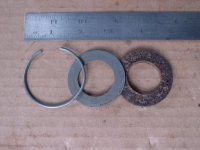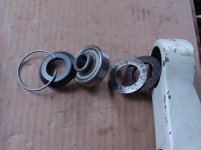leeko
Stainless
- Joined
- Jun 30, 2012
- Location
- Chicago, USA
Hi all,
I'm working on a 1941 hardinge TM, and an getting a lot of chatter with arbor mounted cutters. Looking at the overarm support bracket, the bearing appears to have a little radial play which I'm hoping is the cause and an easy fix. I unscrewed the bearing retainer and knocked out the bearing, which is an MRC 204 SFF. Beyond that step, I'm not sure what to do next. Do the slotted caps on either end of the bearing unscrew? If so, are they right hand? Does the tapered portion slide out of the bearing, or does it need to be pressed out?
Also: is it possible the chatter is due to lack of preload on the spindle bearings? That was the case ony old Gorton 8-1/2, but looking at the parts diagram I don't see any obvious way of adjusting preload on the hardinge?
Any tips would be greatly appreciated, thanks
Lee
Sent from my SM-N920T using Tapatalk
I'm working on a 1941 hardinge TM, and an getting a lot of chatter with arbor mounted cutters. Looking at the overarm support bracket, the bearing appears to have a little radial play which I'm hoping is the cause and an easy fix. I unscrewed the bearing retainer and knocked out the bearing, which is an MRC 204 SFF. Beyond that step, I'm not sure what to do next. Do the slotted caps on either end of the bearing unscrew? If so, are they right hand? Does the tapered portion slide out of the bearing, or does it need to be pressed out?
Also: is it possible the chatter is due to lack of preload on the spindle bearings? That was the case ony old Gorton 8-1/2, but looking at the parts diagram I don't see any obvious way of adjusting preload on the hardinge?
Any tips would be greatly appreciated, thanks
Lee
Sent from my SM-N920T using Tapatalk















